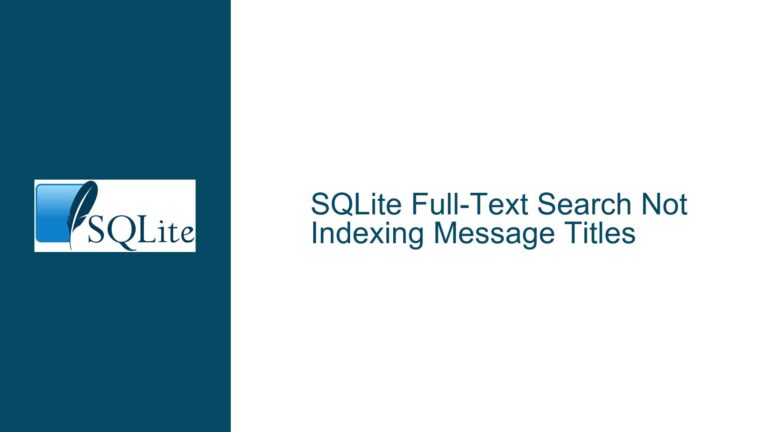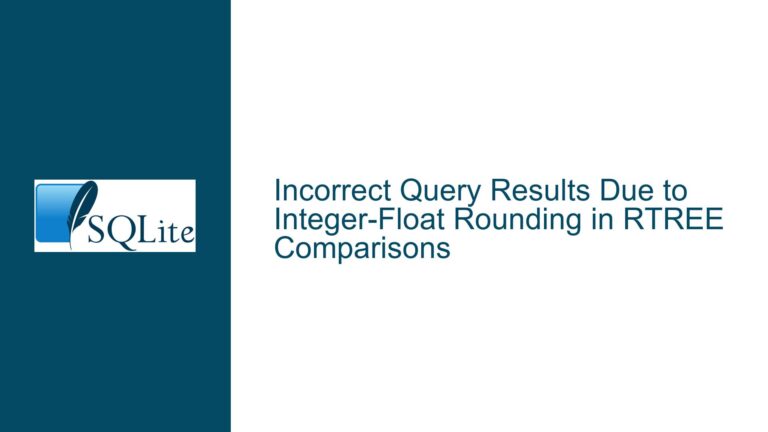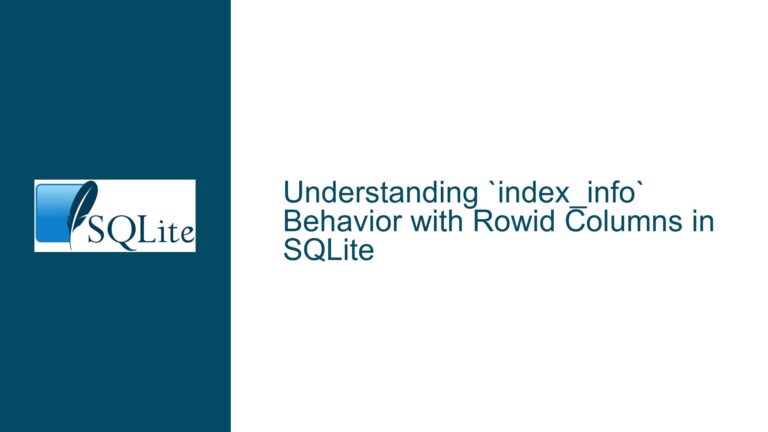SQLite REGEXP Issues with Japanese Characters and End-of-String Anchors
Issue Overview: REGEXP Matching Behavior for Multi-Byte Characters and Syntax Constraints
The core issues revolve around two distinct but related problems in SQLite’s REGEXP function:
Unexpected Matching Failures with Japanese (Multi-Byte) Characters:
- Direct matches for strings containing Japanese characters (e.g.,
日本語) return no results unless specific conditions are met, such as prefixing the regex with^(start-of-string anchor) or using alternations (e.g.,日本語|dummy). - Partial matches (e.g.,
本語or語) fail when combined with^.*but succeed with.*. - Emojis (4-byte Unicode characters) exhibit similar behavior: direct matches fail, while patterns like
.*😎work.
- Direct matches for strings containing Japanese characters (e.g.,
Syntax Errors with
$(End-of-String Anchor) in Complex Patterns:- Using
$in non-terminal positions within a regex (e.g.,ample$|^foo) triggers a "Runtime error: unrecognized character". - Attempting to group
$within parentheses (e.g.,#(1$|200)) causes "unmatched ‘(‘" errors.
- Using
These issues stem from SQLite’s regex engine implementation, which historically had limitations in handling multi-byte Unicode characters and parsing certain regex syntax configurations.
Possible Causes: Multi-Byte Character Processing and Regex Engine Limitations
1. Multi-Byte Character Handling in SQLite’s Regex Engine
SQLite’s default regex engine (a derivative of the public-domain regexp.c library) processes input as a sequence of bytes rather than Unicode code points. This leads to incorrect behavior with multi-byte UTF-8 characters:
- 3-Byte and 4-Byte Characters: Japanese characters like
日(U+65E5) and emojis like😎(U+1F60E) are encoded as 3-byte and 4-byte UTF-8 sequences, respectively. The regex engine’s byte-oriented logic fails to treat these sequences as single logical characters.- Example: Matching
^日本語works because the engine anchors the match to the start of the string, aligning byte offsets. However,日本語(without^) fails because the engine may misinterpret intermediate bytes as standalone characters.
- Example: Matching
- Greedy Quantifiers and Lookaheads: Patterns like
^.*日本語fail because.*consumes bytes greedily, potentially "overshooting" valid multi-byte boundaries and leaving an invalid fragment for the subsequent日本語match.
2. Syntax Parsing Limitations for $ Anchors
The $ anchor is designed to assert the end of a string. However, SQLite’s regex engine historically enforced strict parsing rules:
- Positional Constraints: In older versions,
$was only recognized as an end-of-string anchor if it appeared at the very end of the regex pattern. Placing$earlier (e.g.,ample$|^foo) confused the parser, leading to syntax errors. - Parentheses and Grouping: Using
$within groups (e.g.,#(1$|200)) triggered parser errors due to incomplete handling of nested syntax elements.
3. Encoding Configuration Missteps
While SQLite supports UTF-8 and UTF-16 via PRAGMA encoding, misconfigurations or incorrect assumptions about encoding conversions can exacerbate regex issues:
- UTF-16 Pitfalls: Setting
PRAGMA encoding="UTF-16le";does not retroactively convert existing data. Tables created before switching encoding retain their original encoding, leading to inconsistent regex behavior. - Collation Sequences: The default
BINARYcollation treats strings as raw byte sequences, which can misalign with Unicode-aware regex expectations.
Troubleshooting Steps, Solutions & Fixes
1. Apply Patches or Upgrade SQLite
The root cause of the Japanese character matching issue was addressed in SQLite check-in c94595a6e15490b4, which modifies regexp.c to properly advance through multi-byte UTF-8 characters:
- Steps:
- Rebuild SQLite with the patched
regexp.cor upgrade to a version including this fix (SQLite 3.39.0+). - Verify the fix by re-running the failing regex queries.
- Rebuild SQLite with the patched
For the $ anchor issue, an enhancement in SQLite trunk (post-3.39.0) improves regex parsing:
- Steps:
- Build SQLite from the latest trunk source.
- Test complex patterns like
ample$|^fooand#(1$|200).
2. Adjust Regex Patterns for Multi-Byte Awareness
When working with multi-byte characters, structure regex patterns to align with SQLite’s byte-oriented engine:
- Explicit Anchors: Use
^and$to anchor matches, reducing ambiguity in byte alignment.- Example:
SELECT * FROM TESTTABLE WHERE regexp('^日本語$', TESTSTRING);
- Example:
- Avoid Greedy Quantifiers with Partial Matches: Replace
^.*日本語with.*日本語to allow flexible backtracking. - Escape Critical Characters: Ensure
$,^, and|are properly escaped or positioned.
3. Use Unicode-Aware Alternatives
If regex limitations persist, consider SQLite’s built-in string functions or extensions:
LIKEandGLOBwith Wildcards:-- Match exact string SELECT * FROM TESTTABLE WHERE TESTSTRING = '日本語'; -- Match suffix SELECT * FROM TESTTABLE WHERE TESTSTRING GLOB '*語';- User-Defined Functions (UDFs):
Integrate a Unicode-aware regex library (e.g., PCRE2) via SQLite’s loadable extension mechanism.
4. Validate Encoding and Collation Settings
Ensure consistent encoding across the database lifecycle:
- Set Encoding at Creation:
PRAGMA encoding="UTF-8"; -- Or UTF-16le/beBefore creating tables.
- Use Unicode Collations:
CREATE TABLE TESTTABLE( ID INTEGER PRIMARY KEY AUTOINCREMENT, TESTSTRING TEXT COLLATE ICU );(Requires SQLite compiled with ICU extension.)
5. Workarounds for $ Anchor Limitations
For older SQLite versions without the trunk fix, redesign regex patterns to avoid $ in non-terminal positions:
- Factorize Alternations:
-- Original failing pattern: ample$|^foo -- Rewrite as: SELECT * FROM TESTTABLE WHERE regexp('^foo', TESTSTRING) OR regexp('ample$', TESTSTRING); - Leverlookaheads (Advanced):
Use UDFs for lookahead support if critical.
6. Comprehensive Testing for Edge Cases
After applying fixes, test extensively with:
- Multi-byte characters across UTF-8/UTF-16.
- Emojis, CJK ideographs, and combining characters.
- Complex regex patterns involving anchors, groups, and alternations.
By addressing SQLite’s regex engine limitations through patches, pattern adjustments, and encoding best practices, developers can achieve consistent Unicode-aware matching and avoid syntax-related runtime errors.






